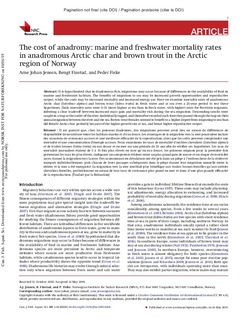The cost of anadromy: marine and freshwater mortality rates in anadromous Arctic char and brown trout in the Arctic region of Norway
Peer reviewed, Journal article
Published version

Åpne
Permanent lenke
http://hdl.handle.net/11250/2620099Utgivelsesdato
2019Metadata
Vis full innførselSamlinger
- Scientific publications [1392]
Originalversjon
10.1139/cjfas-2018-0428Sammendrag
It is hypothesized that in diadromous fish, migrations may occur because of differences in the availability of food in marine and freshwater habitats. The benefits of migration to sea may be increased growth opportunities and reproductive output, while the costs may be increased mortality and increased energy use. Here we examine mortality rates of anadromous Arctic char (Salvelinus alpinus) and brown trout (Salmo trutta) in fresh water and at sea over a 25-year period to test these hypotheses. Daily mortality rates were 5–15 times higher at sea than in fresh water, with highest rates for first-time migrants,
inferring a clear trade-off between increased mass gain and mortality risk during the sea migration. Descending smolts were caught in a trap at the outlet of the river, individually tagged, and thereafter recorded each time they passed through the trap on their annual migration between the river and the sea. Brown trout females seemed to benefit to a higher degree from migrating to sea than did female Arctic char, probably because of the higher growth rate at sea, and hence higher reproductive output.
